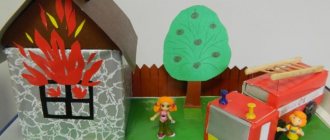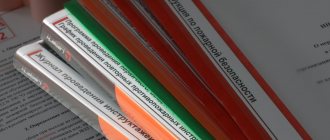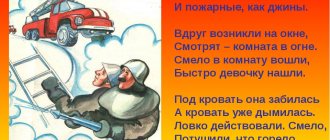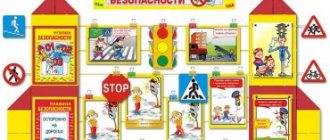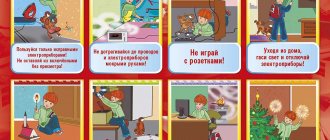Learn fire safety rules
Action plan for children of senior preschool age.
Our little fidgets are in a hurry to explore the world, not realizing the danger that it can bring. And we, adults, cannot always be there to help. That is why it is necessary to develop in children a conscious and responsible attitude towards personal safety and the safety of others. And in this sense, it is very important to introduce them to fire safety rules before school.
Every year we conduct a series of safety events in our kindergarten, the purpose of which is to develop in children the skills of careful handling of fire and an understanding of the need to comply with fire safety rules.
Tasks
- Give children initial information about the causes of a fire.
- Introduce the properties and qualities of objects in terms of their fire hazard.
- Give an idea of the work of firefighters and their professional actions.
- Teach children the rules of safe behavior in the event of a fire: be able to navigate the space of a group room, apartment, know the first actions in the event of a fire, be able to call the rescue service “01”.
- Develop a cautious attitude towards objects that are high sources of fire hazard.
- Foster respect for the firefighting profession.
- Foster a desire to provide mutual assistance and take care of your life and health.
The formation of the foundations of children’s life safety is carried out in different directions, the main ones being work with children, parents, teaching staff and staff. It is important not only to protect the child from danger, but also to prepare him to face possible difficulties, to form an understanding of the most dangerous situations, the need to take precautions, and to instill in him the skills of safe behavior in everyday life together with his parents, who act as role models for the child.
April
I. Methodological work
1. Work with children.
A. Organized educational activities:
- Reading fiction. Cognition. Safety. Communication. Reading the poem by S. Marshak “The Story of an Unknown Hero.”
- Cognition. Safety. Communication. Conversation “Why does a fire occur?”
- Cognition. Safety. Communication. Conversation “If there is a fire in the house.”
- Cognition. Work. Safety. Communication. Conversation “Firefighter is a heroic profession.”
- Cognition. Work. Communication. Excursion to the fire station. Introducing the fire truck.
- Artistic creativity. Cognition. Reading fiction. Safety. Communication. Drawing based on impressions from the work read and from the excursion. X Reading fiction. Cognition. Safety. Communication. Reading the work of S. Marshak “Cat’s House”.
- Work. Cognition. Socialization. Reading fiction. Communication. Joint activities with the teacher. Making masks for the dramatization game “Cat House”.
B. Independent activities of children:
- Physical Culture. Socialization. Health. Outdoor game “Who is faster?”
- Socialization. Cognition. Safety. Communication. Didactic game “Objects are sources of fire.”
- Socialization. Cognition. Safety. Communication. Role-playing game “We are firefighters.”
- Cognition. Socialization. Safety. Communication. Didactic game “What does a firefighter need?”
B. Cultural and leisure activities:
- An evening of entertainment. Cognition. Reading fiction. Safety. Communication. Dramatization game "Cat's House".
- An evening of entertainment. Cognition. Safety. Communication. Quiz "Fire is the enemy."
- Artistic creativity. Cognition. Safety. Communication. Drawing. Exhibition of children's works "Fire: friend or foe?"
2. Interaction with personnel.
- Thematic exhibition “Introducing fire safety rules to preschoolers.”
- Instruction “Protecting the life and health of children.” X Design of the “Service 01” stand.
II. Interaction with parents
- Consultation: “Personal safety of the child.”
May
I. Methodological work
1. Work with children.
A. Organized educational activities:
- Reading fiction. Cognition. Safety. Communication. Reading of E. Khorinsky’s poem “The Little Match.”
- Cognition. Safety. Socialization. Music. Reading fiction. Communication. “Matches are not for playing.”
- Cognition. Safety. Communication. Excursion to the laundry. Introduction to the operation of an electric iron.
- Cognition. Safety. Socialization. Reading fiction. Communication. “Don’t dry your pants over the gas after washing, otherwise your pants will leave holes!”
- Cognition. Safety. Communication. Conversation “So that there is no fire.”
- Cognition. Safety. Communication. Conversation “If there is a fire in the house. Phone 01.”
- Safety. Cognition. Socialization. Communication. Training games to develop children's safe behavior skills.
B. Independent activities of children:
- Safety. Cognition. Socialization. Communication. Didactic game “It burns - it doesn’t burn.”
- Physical Culture. Health. Socialization. Outdoor game "Fast and dexterous."
- Safety. Cognition. Socialization. Communication. Didactic game “What can’t be done in the absence of adults?”
- Socialization. Cognition. Safety. Communication. Role-playing game “We are firefighters.”
- Safety. Cognition. Socialization. Communication. Didactic game “In the world of dangerous objects.”
- Socialization. Cognition. Safety. Health. Communication. Role-playing game “Hospital” (providing first aid to a fire victim).
B. Cultural and leisure activities:
- Artistic creativity. Cognition. Safety. Communication. Drawing. Children's drawing competition "Fire is a friend, fire is an enemy."
- An evening of entertainment. Cognition. Safety. Communication. Quiz “Take care of your house from fire!”
2. Interaction with personnel.
- Thematic exhibition “Fire Safety”.
- Organization of a practical lesson “Evacuation of children in case of fire.”
II. Interaction with parents
- Consultation: “Rules of conduct and actions in fire conditions.”
- Design of a thematic exhibition (from joint works of students, parents and teachers) “Take care of nature from fire!”
Lidiya Glazkova, senior teacher of the MBDOU
“Kindergarten for general developmental type “Vasilyok”, r.p. Mullovka, Melekessky district, Ulyanovsk region
Don't joke with fire, so you don't regret it later!
Contained in sections:
- Safety, life safety. Lesson notes 4247
- Fire safety 7488
Includes sections:
- Fire in the forest. Protecting the forest from fire 161
By groups:
- Senior group
- Preparatory group
- Middle group
- Junior group
Showing publications 1-10 of 2495. All sections | Fire safety. Class notes
New
Photo
The best
Photo report on GCD for modeling using the plasticine technique in the senior group on the topic “Fire extinguisher”
Preschoolers are little pioneers. The desire to constantly explore the world often confronts them with real dangers, and one of them is the threat of fire . During the school year, teachers constantly work on fire safety : conversations using visuals...
Summary of the conversation about fire safety rules in the senior group
Goal: To develop in children a conscious and responsible attitude towards compliance with fire safety . To equip with the knowledge, skills and abilities necessary to act in extreme situations. Objectives: Educational To give children the concept that fire can be a friend, and...
Rules for children's behavior in case of fire
If there are no adults near the child during a fire, he will have to make his own decisions and act confidently. To do this, parents or teachers must teach him the chain of actions in case of fire.
- Call 01/112 and report your location and emergency situation.
- Ask your neighbors for help and tell them about the fire.
- Do not hide in hard-to-reach places; rescuers simply will not be able to come to the rescue or find the victim.
- Do not use the elevator during a fire. Go down stairs only.
- Follow all instructions from firefighters and rescuers who arrived at the scene.
Action plan to ensure fire safety in preschool educational institutions
Fire safety in preschool educational institutions is ensured by carrying out effective organizational and technical measures aimed at ensuring the security of the facility.
Technical measures include equipping the building with a fire alarm, an automatic fire extinguishing system, an internal fire water supply system, and a set of primary fire extinguishing means.
Organizational ones include developing an evacuation plan, issuing an order appointing those responsible for fire safety at facilities, training personnel, conducting fire safety briefings, training students in the rules of behavior in case of fires, concluding maintenance contracts and periodically inspecting fire protection and automation equipment.
The preschool educational institution is obliged to annually develop and implement a fire safety action plan and monitor the performance of fire protection equipment. The fire safety action plan is a mandatory document.
The fire safety plan is drawn up taking into account the fact that the head of the preschool educational institution is responsible for:
Maintaining in good condition the installed security and fire alarm systems, emergency automatic fire extinguishing, internal fire water supply, fire protection equipment, including primary fire extinguishing means - fire extinguishers of all types, fire shields.
Conducting fire prevention propaganda, training workers in fire safety measures. Workers must be able to navigate the evacuation plan, know the procedure in case of fire, and how to evacuate material assets from the building.
Inclusion of industrial safety issues in the collective agreement. Article 37 of Law No. 69 does not specify how this will actually be implemented. This could be additional funding for participation in fire safety events or the establishment of bonuses for employees for their success in fire prevention, for selfless actions during fire extinguishing.
Template for drawing up a plan for industrial safety
PLAN of measures to ensure fire safety in preschool educational institution No. ____ for 20____ - 20____ Goals
:
- Maintaining in good condition the installed fire alarm systems, emergency automatic fire extinguishing, internal fire water supply, fire protection equipment, including primary fire extinguishing means - fire extinguishers of all types, fire shields;
- Conducting fire prevention propaganda, training workers in fire safety measures. Workers must be able to navigate the evacuation plan, know the procedure in case of fire, how to evacuate material assets from the building;
- Improving the work of preschool employees to prevent child deaths and injuries in fires;
- Systematizing children's knowledge about the causes of fires, leading to an understanding of the likely consequences of children's pranks;
- Formation in children of safe behavior skills at home, a sense of increased danger when handling fire and electrical appliances, compliance with safety precautions when handling them;
- Training in rules of behavior in case of fire;
- Introducing children to the profession of a firefighter and the equipment that helps extinguish a fire;
- Increasing parents' attention to learning fire safety rules and preventive measures at home and in nature.
| No. | Event name | Date | Responsible executor, co-executors: | Completion mark |
| 1. Organizational and technical measures | ||||
| 1. | Preparing kindergarten for the new school year:
| Until September 1 | Deputy for AHR | |
| 2. | Checking the presence and condition of evacuation plans, stencil signs for the location of fire extinguishers, and telephones on the floors. | Until September 1 | Responsible for industrial safety | |
| 3. | Study of regulatory documents on fire safety at the federal and regional levels | constantly | Head of preschool educational institution, Responsible for industrial safety | |
| 4. | Development and approval of local documents on fire safety measures:
| Until September 1 | Head of preschool educational institution | |
| 5. | Checking the availability (updating) of fire safety instructions and visual propaganda. Providing plans and instructions for the evacuation of kindergarten students and staff. | Once every six months | Head of preschool educational institution, Responsible for industrial safety | |
| 6. | Signing acts in accordance with fire safety regulations. | On schedule | Head of preschool educational institution | |
| 7. | Consideration at administrative meetings and pedagogical councils of the state of fire safety in preschool educational institutions and the adoption of priority measures to strengthen the fire safety regime. | During the year according to the preschool educational plan | Head of preschool educational institution, Responsible for industrial safety | |
| 8. | Regular preparation of visual campaigning on fire safety. | During a year | Responsible for industrial safety | |
| 9. | Purchase of didactic games and visual aids for studying fire safety rules with students and employees | During a year | Deputy according to AHR, Art. teacher | |
| 10. | Monitoring compliance with fire safety requirements:
| During a year | Responsible for industrial safety | |
| 11. | Checking the serviceability of outdoor lighting, electrical sockets, switches, maintenance of electrical networks, the condition of electrical equipment, lighting and household electrical systems. | constantly | Responsible for industrial safety | |
| 12. | Monitoring compliance with safety rules in the workplace and fire safety regulations. | constantly | Responsible for industrial safety | |
| 13. | Preparation of necessary measures to eliminate identified violations, strengthening control over the implementation of fire prevention measures | As needed | Responsible for industrial safety | |
| 14. | Carrying out systematic inspections of the territory to ensure a fire-safe environment (clutter, lighting fires, storing building materials in areas adjacent to preschool structures) | constantly | Responsible for industrial safety | |
| 15. | Checking the insulation resistance of the electrical network and equipment grounding | During a year | Under contract | |
| 2. Work with the preschool educational institution team | ||||
| 1. | Consideration at administrative meetings and pedagogical councils of the state of fire safety in preschool educational institutions and the adoption of priority measures to strengthen the fire safety regime. | Head of preschool educational institution, Responsible for industrial safety | ||
| 2. | Approval at the general meeting of the collective fire safety work plan for the new academic year. | August | Head of preschool educational institution | |
| 3. | Organization and conduct of training and testing of knowledge of fire safety requirements for kindergarten workers. | During a year | Responsible for industrial safety | |
| 4. | Conducting induction training for newly hired employees. Conducting repeated fire safety briefings at the workplace with employees. Conducting ongoing fire safety training. | As needed September, March (once every six months) throughout the year | Responsible for industrial safety | |
| 5. | Briefings with employees during public events (New Year's parties, matinees, graduation parties, etc.) | During a year | Responsible for industrial safety | |
| 6. | Practical exercises on developing an evacuation plan in case of fire. | According to the training schedule | Responsible for industrial safety | |
| 7. | Training teachers to familiarize children with fire safety rules. | According to the preschool educational plan | Senior teacher, Responsible for PB | |
| 3. Work with students and their parents | ||||
| 1. | Design of fire safety corners in group rooms. Purchasing didactic games and visual aids for studying fire safety rules with students. Interaction with parents (legal representatives) of students to reinforce and comply with fire safety rules at home. | During a year | Senior teacher, teachers | |
| 2. | Organizing and conducting conversations, classes, and other events with students according to the Fire Safety Rules. | According to a separate plan | Senior teacher, teachers | |
| 3. | Conversations - briefings on fire safety rules and behavior in the event of a fire. | During a year | Educators | |
| 4. | Organization and holding of drawing competitions, quizzes on fire safety issues. | During a year | Senior teacher | |
| 5. | Participation in regional competitions of children's and family creativity on fire-fighting topics. | During a year | Senior teacher | |
| 6. | Development of standards and practical skills for behavior in case of emergencies (fires) during Children's Day. | May | Responsible for PB, senior teacher | |
| 7. | Carrying out the annual month “Children against fire fun”. | April May | Responsible for PB, senior teacher | |
Teaching materials and possible topics
Conversations:
- If there is a fire in the house;
- Firefighter is a heroic profession;
- Causes of fires;
- Don't touch the matches - there is fire in the matches;
- About the benefits of household electrical appliances and the rules for using them;
- Kids about fire;
- Good and evil fire;
- If there is a fire;
- Firefighter number-01;
- Fire is a man's friend, just don't touch it in vain;
- And we have gas in our apartment;
- Labor of firefighters;
- Bonfire in the forest.
Reading fiction:
- Marshak Samuil Yakovlevich
- "What's burning?"
- "Fire",
- "Cat house",
- "The Story of an Unknown Hero"
- "The Tale of Matches";
- Zhitkov Boris Stepanovich
- "Fire at Sea"
- "Smoke";
- "Confusion";
- "Fire Dogs"
- "Fire",
- "Smoke";
- "Bad advice";
- "Uncle Styopa";
- “Where the red cars rush”;
- “How they caught Coal”;
- “How man tamed fire”;
- “How Fire Married Water”
- "Fire engine";
- “Once upon a time there lived a baby elephant”;
- “Fire in the outbuilding or feat in the ice”
- "The Tale of the Hare's House and the Dangerous Box";
- "Small matches"
- “Both dad and mom scold Seryozha...”;
- "Matches",
- "New Year".
- "The grass is burning"
- "The fire is burning."
- "The Sparrow and the Fire."
Visual activities:
- drawing illustrations for works of fiction;
- making a greeting card for Firefighter Day;
- drawing “Where the red cars rush”, “Fire”;
- modeling “Fire dogs”, “Fire engines”;
- construction of paper crafts “Fire Truck”.
Games:
- role-playing “Calling the Firefighters”, “Going to the Fire”, “Fire Station”, “Your First Actions in a Fire”;
- moving “Fire in the hearth”, “Firemen in training”, “Rescuing victims”, “Earth, water, fire, air”, “Fire dragon”, “Birds in trouble”;
- theatrical “Brave Bunny”;
- online games “Fire Truck Online Coloring Book”;
- didactic “It burns - it doesn’t burn”, “Say the word”, “Fire extinguishing equipment”, “Who needs what for work”, “Loto-fire safety”, “How to avoid trouble”, “Fold the picture”, “Fire hazardous items”, “What does a fireman need?”, “Where is Cheburashka calling?”, “Wonderful matches”, “Good-bad”, “Guess the riddle”;
- modeling the situations “Bengal lights were lit in the house”, “Mom left clothes to dry over the stove”, “Dad left a pan on the stove”, “Grandma forgot to turn off the iron”.
Excursions:
- in kindergarten “Introduction to fire alarms”;
- in kindergarten “Escape Routes”;
- to the kitchen of the preschool educational institution “Introduction to electrical appliances”;
- to the local fire department.
Activities with children
The purpose of educational activities is to teach children how to safely handle fire at home and how to behave in case of fire. Children are explained which things and objects pose the greatest fire hazard. Particular attention is paid to the topic of careless handling of fire.
Thematic events on fire safety with kindergarten students are not limited to presenting ready-made rules in conversation or reading fiction. Children actively participate in the learning process through active, didactic and role-playing games.
For children of older and graduating groups, educational excursions to the fire station are organized, with a mandatory visit to the fire station museum.
Pupils get acquainted with the personnel of the duty guard. Children are shown various equipment, cars, fire extinguishers, professional rescue equipment and rescue equipment.
Based on the results of studying fire safety rules, competitions of drawings, applications, and crafts made from plasticine and clay are organized. Teachers conduct fire relay races and quizzes. Healthy rivalry and competitive spirit are the key to children’s compliance with fire safety rules in kindergarten and at home.
Information about fire safety activities with preschoolers is brought to the attention of parents. Exhibitions with competitive drawings and children's crafts about fire safety are presented for public viewing.
Analysis of children's learning of educational material and consultations on ensuring the child's safety at home and in public places are carried out at parent-teacher meetings.
Active cooperation with families was clearly expressed in holding joint cleanup days. Cleaning the area from highly flammable dry grass, fallen leaves and branches is a clear example of compliance with fire safety standards on the territory of a kindergarten.
Briefings with employees
Local fire safety instructions are developed by the head of the preschool institution, in accordance with regulatory documents and design features of the building (heating circuit, fire water supply and alarm system).
The instructions consist of two parts: guidelines for employee compliance with fire safety regulations, and rules of conduct for employees in case of fire.
Employees begin to perform their job duties upon entering work, after undergoing mandatory initial fire safety training. Repeated briefings are carried out once every six months.
The instructions clearly specify the actions of workers when extinguishing a fire. An employee who notices a fire reports information about the fire to the caretaker, calls and meets the fire brigade.
The caretaker notifies employees about the fire. The evacuation of children is carried out under the guidance of the head of the kindergarten . Searches in the burning zone are stopped if there are no children in the room.
